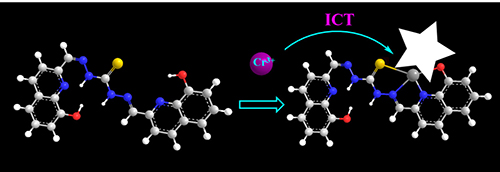| [1] Vincent, J. B. Proc. Nutr. Soc. 2004, 63, 41.
[2] Filik, H.; Dondurmacioglu, F. J. Anal. Chem. 2009, 64, 455.
[3] Wang, Y. T. J. Ind. Microbiol. Biotechnol 1995, 14, 159.
[4] Filik, H.; Dondurmacioglu, F. J. Anal. Chem. 2009, 64, 455.
[5] Chalmardia, G. B.; Tajbakhsha, M. Tetrahedron 2018, 18, 40.
[6] Gou, C.; Qin, S. H.; Wang, Y.; Liu, X. Y. Inorg. Chem. Commun. 2011, 14, 1622.
[7] Azadbakht, R.; Keypour, H. Spectrochim. Acta, Part A 2012, 85, 293.
[8] Vincent, J, B. Nutr. Rev. 2000, 58, 67.
[9] Anderson, R. A. Regul. Toxicol. Pharmacol. 1997, 26, 35.
[10] Filik, H.; Dondurmacioglu, F. J. Anal. Chem. 2009, 64, 455.
[11] Gómez, V.; Callao, M. P. TrAC, Trends Anal. Chem. 2006, 25, 1006.
[12] Lu, J. S.; Tian, J. Y.; Wu, H. Chin. J. Anal. Chem. 2009, 37, 99.
[13] Xu, K. X.; Kong, H. J.; Li, Q.; Song, P.; Dai, Y. P.; Li, Y. Spectrochim. Acta, Part A 2015, 137, 957.
[14] Kamakura, N.; Inui, T.; Kitano, M.; Nakamura, T. Spectrochim. Acta, Part B 2014, 93, 28.
[15] Li, M.; Zhang, D.; Liu, Y.; Ding, P. J. Fluorescence 2014, 24, 119.
[16] Noorbasha, N. M.; Jiangb, S. J. Talanta 2009, 80, 173.
[17] Zhang, N.; Suleiman, J. S.; He, M. Talanta 2008, 75, 536.
[18] Aydan, F. A.; Soylak, M. J. Hazard. Mater. 2010, 173, 669.
[19] Xie, X.; Tang, F.; Shangguan, X.; Che, S.; Niu J.; Xiao, Y.; Wang, X.; Tang, B. Chem. Commun. 2017, 53, 6520.
[20] Dai, Y. P.; Fu, J. X.; Yao, K.; Song, Q. Q.; Xu, K. X. Spectrochim. Acta, Part A 2018, 192, 257.
[21] Dolaia, M.; Sahab, U.; Dasc, A. K.; Kumarb, G. S. Anal. Methods-UK 2018, 10, 4063.
[22] Liu, X. Y.; Wang, P.; Fu, J. X.; Yao, K.; Xue, K.; Xu, K. X. J. Lumin. 2017, 186, 16.
[23] Brewer, T. F.; Chang, C. J. J. Am. Chem. Soc. 2015, 137, 10886.
[24] Keck, J.; Kramer, H. E. A.; Port, H.; Hirsch, T.; Fischer, P.; Rytz, G. J. Phys. Chem. 1996, 100, 14468.
[25] Hou, S. H.; Qu, Z. G.; Zhong, K. H.; Bian, Y. J.; Tang, L. J. Chin. J. Org. Chem. 2016, 36, 768(in Chinese).(侯淑华, 曲忠国, 钟克利, 边延江, 汤立军, 有机化学, 2016, 36, 768.)
[26] Yao, K.; Fu, J. X.; Chang, Y. X.; Li, B.; Li, Y.; Xu, K. X. Spectrochim. Acta, Part A 2018, 205, 410.
[27] Zhang, P.; Wang, H.; Zhang, D.; Zeng, X.; Zeng, R.; Xiao, L.; Tao, H.; Long, Y.; Yi, P.; Chen, J. Sens. Actuators, B 2018, 255, 2223.
[28] Fu, Y. J.; Yao, H. W.; Zhu, X. Y.; Guo, X. F.; Wang, H. Anal. Chim. Acta 2017, 994, 1.
[29] Dai, Y. P.; Liu, X. Y.; Wang, P.; Fu, J. X.; Yao, K.; Xu, K. X. RSC Adv. 2016, 6, 99933.
[30] Wang, P.; Fu, J. X.; Yao, K. Chang, Y. X.; Xu, K. X. Sens. Actuators, B 2018, 273, 1070.
[31] Samir, M.; Milan, S.; Debasish, D.; Prativa, M.; Gobinda, P.; Sahoo, A. Sens. Actuators, B 2017, 248, 223. |
